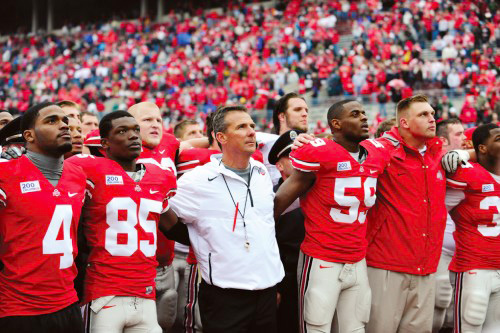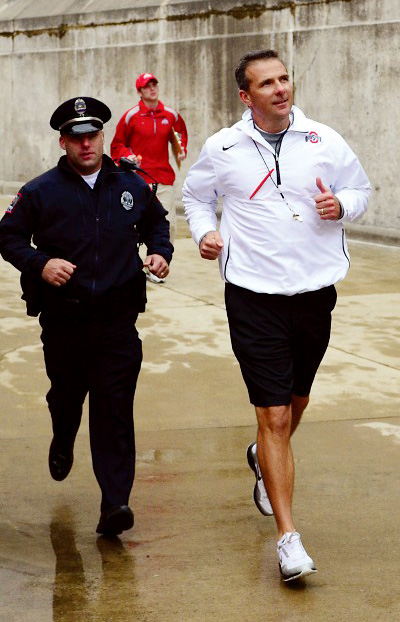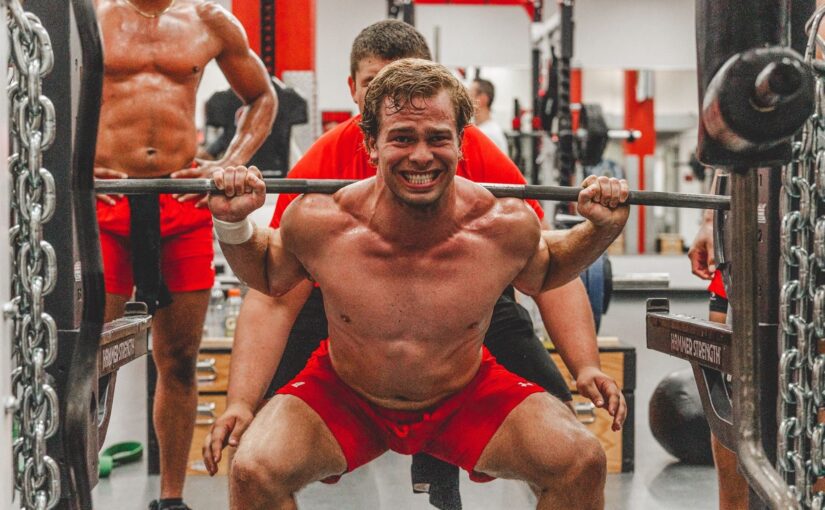Starting with a clean slate
Ohio State’s Urban Meyer bypassed watching video on his Buckeyes so they can prove themselves on the field

The job offer is made. You accept. What’s the first thing you do?
Most coaches begin stockpiling hours of footage about their new players. They want to figure out what kind of talent they have, who plays where, who works well together and what to expect before stepping on the field. But, if you’re one of the most successful college football coaches of the last decade, you do none of that.Urban Meyer, who has taken over his alma mater, the Ohio State football program after a tumultuous 6-7 season last year, says cleaning the slate is a great way to start fresh with players.
Don’t get him wrong, Meyer did his due diligence before accepting the position. As an Ohio State graduate (Meyer earned his master’s in 1988 and served two years as a grad assistant with the Buckeyes), Meyer already knew about the outstanding academics at the school. He also was well aware of the program’s recent struggles and bad press. It’s hard to escape your alma mater being banned from the 2012 postseason fand having one of its most successful coaches ever, Jim Tressel, fired.
But, Meyer says his plan when taking over Ohio State was not to dwell on past failures, which is why he didn’t watch any tape of his new players after taking the job on Nov. 28, 2011. At a school looking to rebuild its image, Meyer says everyone deserves a second chance when it comes to on-field capabilities. Heading into spring practice and eventually the fall season, Meyer was looking for healthy competitions at every position, rather than the complacency that sometimes accompanies athletes with guaranteed playing time.
“I was tempted to watch tape on everyone, I really was,” Meyer admits. “But, I wanted each player to have an opportunity and a fresh start. I told the players that I didn’t have any formed opinions of them ahead of time.
“At this age, players sometimes need to push the reset button and get a second chance.”
Securing the coaching staff
While Meyer may not have spent his initial days on the Ohio State campus breaking down game film of individual players, he did put together an impressive staff of coaches. Instead of cleaning house, Meyer kept three coaches under the previous Ohio State leadership (Luke Fickell, Stan Drayton and Mike Vrabel) and added six new assistants to the Buckeye program (Everett Withers, Tom Herman, Ed Warinner, Kerry Coombs, Tim Hinton and Zach Smith).
Meyer says there are three qualities he wants in every assistant coach on his staff.
1. Character. Meyer mentions this quality first for a reason — it’s the most important in his eyes. “You have to be a quality person or I won’t hire you,” Meyer says. “That means being a good husband and father first, and it also means how you treat the players.”
2. Involvement. Meyer wants an assistant who has complete involvement in lives of the players within his unit. “The coach needs to know what the player’s major is, who he’s dating, what his parents are like … everything.”
3. Coaching smarts. Meyer insists having a great coaching mind is important but is third on the list. “We want them to have worked in enhanced schemes, but we are not specifically looking for gurus.”
Meyer says being well-versed in the first two qualities makes for a great recruiter, which is something he needs from each of his assistants as well. Add it all together, and Meyer expects and demands a lot of his coaches, but not necessarily just on the field or in the film room.
“Coach Meyer expects the same thing from all the assistant coaches — that you do everything you can do every single day to develop the young men in our charge to be the best students, football players and citizens they can be,” says Kerry Coombs, a 30-year coaching veteran in his first season with Ohio State. “Coach also expects us to be the best in the country at our craft, and he gives us the resources necessary to do that. We develop, we coach and we recruit every day.”
Building confidence, mastering motivation
Meyer enters his tenure at Ohio State with an impressive pedigree — a 0.819 winning percentage (104-23) during his 10-year coaching career and two national championships (2006 and 2008 with Florida). That alone should instill confidence in the current crop of Buckeyes that Meyer can get the job done in Columbus. Beyond just credentials, however, Meyer is known as a coach who finds a way to build confidence in his players.

“I’m honest with players. I don’t let them have false confidence,” Meyer says. “I give them honest evaluations. I also place players in situations where they can succeed.” Meyer cites a generic example of a safety who hasn’t grown into his position on the defense yet but shows great glimpses of speed and awareness, two qualities he wants in a kickoff returner. So, this safety moves into a critical role on the special teams and earns confidence in front of his peers.
“There is nothing insignificant on our teams, especially special teams. I like to pinpoint the strengths of players in front of the entire team, so they know why this individual is helping us achieve our team goals. I try to give as much praise as I can in front of the group.”
Coombs says he’s impressed with Meyer’s methods for building confidence in the short time the two have worked together with the Buckeyes.
“He motivates players to be their best in a variety of ways, including immediate and consistent feedback, and long-term feedback,” Coombs remarks. “When we practice, we compete against each other and we motivate each player on every play to compete to win. Our off-season program is built around motivating players daily in the weight room and the classroom. Players constantly are evaluated on their performance in those areas.
“Those that perform really well are recognized in front of their coaches and their peers for their efforts.”
As players mature and build confidence, Meyer then needs to keep them running at a high level through his methods of motivation. This 2012 season needs an extra level of motivation as Meyer and his Buckeyes are staring down a regular season with no hopes of a bowl game due to NCAA sanctions stemming from Tressel’s tenure. Meyer says this poses a challenge but keeping players focused on a daily basis is something they do regardless of the situation, so this year’s challenge is no different.
“We have weekly discussions with players that go much deeper than Xs and Os. We talk about playing hard, practicing hard and doing everything in their power to be their best and help achieve our goals,” Meyer says.
Moving past the spoken word, Meyer admits there are times in a football season, especially early for a major powerhouse, when motivation needs to come from actions on the practice field. During his time at Florida, the Gators had some early season opponents who weren’t near the level of competition as their rivals in the SEC. It’s in these instances that Meyer says he runs his most difficult practices of the year.
“I coach them hard in practice, really hard,” Meyer says about keeping players motivated when outside forces suggest they should have an “easy” game against a lesser foe. “I want them to worry about simply surviving and getting to the next day.”
Stats to live by — turnovers
While Meyer develops strong young men off the field, on the field he’s molding winners. And, in football’s simplest form, victories come from winning the turnover ratio, according to Meyer. He cites turnover ratio as the No. 1 statistic when analyzing a game (with “net punting” coming in at No. 2 and “total defense” as No. 3).
This makes sense as a Meyer-led team never has finished the season on the wrong side of overall turnover margin. His teams typically dominate this category. Take a look at his head-coaching seasons with the turnover ratio highlighted:
- 2001, Bowling Green, 35-18 (+17)
- 2002, Bowling Green, 27-18 (+9)
- 2003, Utah, 29-20 (+9)
- 2004, Utah, 29-14 (+15)
- 2005, Florida, 31-13 (+18)
- 2006, Florida, 29-24 (+5), national championship
- 2007, Florida, 20-15 (+5)
- 2008, Florida, 35-13 (+23), national championship
- 2009, Florida, 23-16 (+7)
- 2010, Florida, 29-27 (+2)
It all comes down to carrying the ball the proper way, which Meyer describes as, “claw the nose of the ball over the top, press the ball against your rib cage, keep your wrist above your elbow and lock the elbow.”
While Meyer may believe in on-the-field second chances for players, carrying the ball the wrong way doesn’t qualify.
“Every coach on my team teaches ball security. If you don’t carry the ball the right way, you are coming out of the game,” Meyer says.
Click here to learn two passing plays from Urban Meyer.





